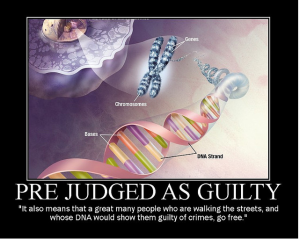Thanks to the incredible DNA technology, changes in law, and criminal databases, police and scientist were able to convict the criminal of a murder case from 1993 seventeen years later! On August 15th, 1993 when James Hawkins was found stabbed and dead in his apartment, the police could not find a lead whose DNA matched the DNA of the murderer’s blood in Hawkins’ apartment and the case was closed.
In 2000, the results from the DNA test of the blood found in Hawkins’ stairs were entered into the national DNA database for law enforcement criminals. Then in 2008 a man named Gorden Francis was convicted of criminal trespassing, a misdemeanor that is categorized as a lower-level offence. Thanks to a law amendment in 2006 that stated convicted criminals of lower-level laws were mandated to provide a DNA sample, Mr. Hawkins murderer was found. With both the DNA from Hawkins’ apartment and Francis’ DNA from his crime in the national DNA database, a match was found. The case was reopened, and Gordon Francis now faces life in jail!
If it weren’t for the incredible enhancements in DNA technology in recent decades many innocent people would still be in jail, and many criminals would not be convicted. The process of DNA profiling is quite meticulous but well worth it. DNA is found in most cells of the body; so at a crime scene a DNA sample can be found in sweat, skin, blood, earwax, saliva, semen, hair. The DNA is then extracted from nucleus of the cell with chemicals that break open the cell and extract the DNA. Then there are various ways to study the DNA but a common technique used is short tandem repeat (STR) analysis. Normally the small STR, regions of non-coding DNA that contain repeats of the same nucleotide, samples are amplified via a polymerase chain reaction (PCR). This copies the DNA similar to the way DNA copies itself in a cell. Once there is enough DNA to study, the STR analysis is used to examine how often base pairs repeat in specific locations on the DNA strand. The FBI declared that 13 specific STR locations are required for DNA analysis. It is extremely unlikely for anyone to have 13 identical STR patterns and location, the chance is greater the 1 in 1 billion. The DNA is then transformed to a DNA “picture” or profile. The profile has columns of dark colored parallel pars that depict the persons STR. In a crime scene, the convicted persons DNA profile would be identical to the DNA profile of the DNA from the crime. Here are two websites that have more detailed explanations of DNA profiling with pictures- site 1, site 2.
Thanks to unit 1 of AP biology, we know where the DNA is found and made in a cell and what the nucleotide sequences in STR are. DNA is a nucleic acid made of many nucleotide monomers consisting of a nitrogenous base, a five-sugar carbon and one phosphate group. The uniquely patterned paired nitrogen bases surrounded by the 2 anti-parallel sugar phosphate backbones makes the double helix structure of DNA.
This “Pre Judged As Guilty Picture” represents the feelings of many people. For example, a judge in Wales, UK thinks it should be mandated that every UK citizen and visitor should have his or her DNA sample stored in a database so the guilty can be convicted and the innocent are freed. Do you think that this is a violation of privacy and a lot of corruption and fraud could end up happening? Or do you think it’s a great idea and every USA citizen should have his or her DNA in a database?



saysquad
This is a great article! Its so cool how scientist/police can discover the identity of a suspect, just by testing a small amount of DNA. Surprisingly, the existence of DNA’s structure, the double helix, was only a recent discovery. In 1953, right down the rad from us, at the COLD Spring Harbor Labs, James Watson and Francis Crick determined the true structure of DNA. This discovery has led to countless scientific breakthroughs. Still, to this day, scientists do not fully understand DNA. For more information on the discovery of the double helix shape, read this article:
http://130.242.18.21/educational/medicine/dna_double_helix/readmore.html
hannahbanana
Wow! This post was very interesting! I do think that every person’s DNA should be in a database because it would help find guilty citizens. Once you commit a crime, you are in the system but not before then. If it is not a violation of privacy to have criminals in databases how could it be to have people who have not committed crimes? DNA should help solve more crimes than it actually does because of the limitations of knowing whose DNA is actually in a crime scene!!
http://www.independent.co.uk/news/uk/crime/dna-database-matches-help-solve-one-crime-in-1300-1918207.html
This is an interesting article, also about the UK, which talks about how few crimes DNA actually helps solve.